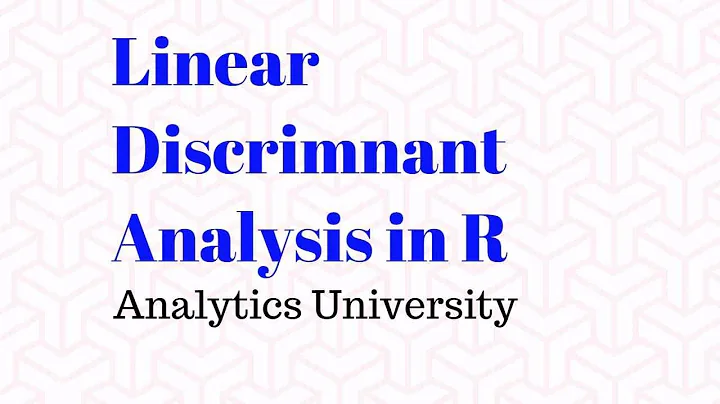Classification functions in linear discriminant analysis in R
Solution 1
There isn't a built-in way to get the information I needed, so I wrote a function to do it:
ty.lda <- function(x, groups){
x.lda <- lda(groups ~ ., as.data.frame(x))
gr <- length(unique(groups)) ## groups might be factors or numeric
v <- ncol(x) ## variables
m <- x.lda$means ## group means
w <- array(NA, dim = c(v, v, gr))
for(i in 1:gr){
tmp <- scale(subset(x, groups == unique(groups)[i]), scale = FALSE)
w[,,i] <- t(tmp) %*% tmp
}
W <- w[,,1]
for(i in 2:gr)
W <- W + w[,,i]
V <- W/(nrow(x) - gr)
iV <- solve(V)
class.funs <- matrix(NA, nrow = v + 1, ncol = gr)
colnames(class.funs) <- paste("group", 1:gr, sep=".")
rownames(class.funs) <- c("constant", paste("var", 1:v, sep = "."))
for(i in 1:gr) {
class.funs[1, i] <- -0.5 * t(m[i,]) %*% iV %*% (m[i,])
class.funs[2:(v+1) ,i] <- iV %*% (m[i,])
}
x.lda$class.funs <- class.funs
return(x.lda)
}
This code follows the formulas in Legendre and Legendre's Numerical Ecology (1998), page 625, and matches the results of the worked example starting on page 626.
Solution 2
Suppose x is your LDA object:
x$terms
You can have a peak at the object by looking at it's structure:
str(x)
Update:
Iris <- data.frame(rbind(iris3[,,1], iris3[,,2], iris3[,,3]),Sp = rep(c("s","c","v"), rep(50,3)))
train <- sample(1:150, 75)
table(Iris$Sp[train])
z <- lda(Sp ~ ., Iris, prior = c(1,1,1)/3, subset = train)
predict(z, Iris[-train, ])$class
str(z)
List of 10
$ prior : Named num [1:3] 0.333 0.333 0.333
..- attr(*, "names")= chr [1:3] "c" "s" "v"
$ counts : Named int [1:3] 30 25 20
..- attr(*, "names")= chr [1:3] "c" "s" "v"
$ means : num [1:3, 1:4] 6.03 5.02 6.72 2.81 3.43 ...
..- attr(*, "dimnames")=List of 2
.. ..$ : chr [1:3] "c" "s" "v"
.. ..$ : chr [1:4] "Sepal.L." "Sepal.W." "Petal.L." "Petal.W."
$ scaling: num [1:4, 1:2] 0.545 1.655 -1.609 -3.682 -0.443 ...
..- attr(*, "dimnames")=List of 2
.. ..$ : chr [1:4] "Sepal.L." "Sepal.W." "Petal.L." "Petal.W."
.. ..$ : chr [1:2] "LD1" "LD2"
$ lev : chr [1:3] "c" "s" "v"
$ svd : num [1:2] 33.66 2.93
$ N : int 75
$ call : language lda(formula = Sp ~ ., data = Iris, prior = c(1, 1, 1)/3, subset = train)
$ terms :Classes 'terms', 'formula' length 3 Sp ~ Sepal.L. + Sepal.W. + Petal.L. + Petal.W.
.. ..- attr(*, "variables")= language list(Sp, Sepal.L., Sepal.W., Petal.L., Petal.W.)
.. ..- attr(*, "factors")= int [1:5, 1:4] 0 1 0 0 0 0 0 1 0 0 ...
.. .. ..- attr(*, "dimnames")=List of 2
.. .. .. ..$ : chr [1:5] "Sp" "Sepal.L." "Sepal.W." "Petal.L." ...
.. .. .. ..$ : chr [1:4] "Sepal.L." "Sepal.W." "Petal.L." "Petal.W."
.. ..- attr(*, "term.labels")= chr [1:4] "Sepal.L." "Sepal.W." "Petal.L." "Petal.W."
.. ..- attr(*, "order")= int [1:4] 1 1 1 1
.. ..- attr(*, "intercept")= int 1
.. ..- attr(*, "response")= int 1
.. ..- attr(*, ".Environment")=<environment: R_GlobalEnv
.. ..- attr(*, "predvars")= language list(Sp, Sepal.L., Sepal.W., Petal.L., Petal.W.)
.. ..- attr(*, "dataClasses")= Named chr [1:5] "factor" "numeric" "numeric" "numeric" ...
.. .. ..- attr(*, "names")= chr [1:5] "Sp" "Sepal.L." "Sepal.W." "Petal.L." ...
$ xlevels: Named list()
- attr(*, "class")= chr "lda"
Related videos on Youtube
Comments
-
 Tyler almost 2 years
Tyler almost 2 yearsAfter completing a linear discriminant analysis in R using
lda(), is there a convenient way to extract the classification functions for each group?From the link,
These are not to be confused with the discriminant functions. The classification functions can be used to determine to which group each case most likely belongs. There are as many classification functions as there are groups. Each function allows us to compute classification scores for each case for each group, by applying the formula:
Si = ci + wi1*x1 + wi2*x2 + ... + wim*xmIn this formula, the subscript i denotes the respective group; the subscripts 1, 2, ..., m denote the m variables; ci is a constant for the i'th group, wij is the weight for the j'th variable in the computation of the classification score for the i'th group; xj is the observed value for the respective case for the j'th variable. Si is the resultant classification score.
We can use the classification functions to directly compute classification scores for some new observations.
I can build them from scratch using textbook formulas, but that requires rebuilding a number of intermediate steps from the lda analysis. Is there a way to get them after the fact from the lda object?
Added:
Unless I'm still misunderstanding something in Brandon's answer (sorry for the confusion!), it appears the answer is no. Presumably the majority of users can get the information they need from
predict(), which provides classifications based onlda(). -
 Tyler about 13 yearsI think something's missing here: there is no terms element in my lda object!
Tyler about 13 yearsI think something's missing here: there is no terms element in my lda object! -
 Brandon Bertelsen about 13 yearsAre you using lda() from the MASS package?
Brandon Bertelsen about 13 yearsAre you using lda() from the MASS package? -
 Tyler about 13 yearsYes, and there's no terms - str() shows: "prior", "counts", "means", "scaling", "lev", "svd", "N", "call"
Tyler about 13 yearsYes, and there's no terms - str() shows: "prior", "counts", "means", "scaling", "lev", "svd", "N", "call" -
 Brandon Bertelsen about 13 yearsStrange, I was using the example at the bottom of ?lda with the Iris data. Perhaps, if you could provide some sample data?
Brandon Bertelsen about 13 yearsStrange, I was using the example at the bottom of ?lda with the Iris data. Perhaps, if you could provide some sample data? -
 Tyler about 13 yearsI'm looking at the lda example now, from R 2.12.2, and there is no reference to terms. What version of R are you using?
Tyler about 13 yearsI'm looking at the lda example now, from R 2.12.2, and there is no reference to terms. What version of R are you using? -
 Tyler about 13 yearsAh, I see now. lda(x, groups) produces different output than lda(groups ~ ., x). However, now that I actually see the terms, there's nothing in there that resembles a classification function. I added a link to the definition of classification functions to my question. Maybe they're in there and I'm too dense to see them?
Tyler about 13 yearsAh, I see now. lda(x, groups) produces different output than lda(groups ~ ., x). However, now that I actually see the terms, there's nothing in there that resembles a classification function. I added a link to the definition of classification functions to my question. Maybe they're in there and I'm too dense to see them? -
 Brandon Bertelsen about 13 yearsMy bad, I misunderstood what you are looking for. My answer does not solve your problem.
Brandon Bertelsen about 13 yearsMy bad, I misunderstood what you are looking for. My answer does not solve your problem. -
 Tyler about 13 yearsNo worries. Thanks for your perseverance.
Tyler about 13 yearsNo worries. Thanks for your perseverance. -
 Tyler over 11 yearsI didn't ask about discriminant functions, I asked about classification functions. They are not the same thing. See the link for a description.
Tyler over 11 yearsI didn't ask about discriminant functions, I asked about classification functions. They are not the same thing. See the link for a description. -
 IRTFM over 11 yearsRight. A classification function projects the data onto the discriminant functions and discretizes it based on a threshold rule. If you wnat to see how MASS::predict.lda does it then load MASS and type
IRTFM over 11 yearsRight. A classification function projects the data onto the discriminant functions and discretizes it based on a threshold rule. If you wnat to see how MASS::predict.lda does it then load MASS and typegetAnywhere(predict.lda). -
 Tyler over 11 yearsThere is one classification function for each group in an lda, as indicated in the link I provided, as well as the book I cited. I've now included a quote from the linked page to clarify, so that we can at least be sure we're arguing about the same thing.
Tyler over 11 yearsThere is one classification function for each group in an lda, as indicated in the link I provided, as well as the book I cited. I've now included a quote from the linked page to clarify, so that we can at least be sure we're arguing about the same thing.predict.ldaprovides the results of applying the classification functions, but it does not return the functions themselves. That's what I asked for. I still don't understand what was flawed or misleading about this question. -
Juanchi almost 9 yearsI'm looking for the same thing (stackoverflow.com/questions/30495710/…). In SAS, it's really easy to get from a LDA.(support.sas.com/documentation/cdl/en/statug/63033/HTML/default/…)





![[EN] R statistics: linear discriminant analysis (LDA)](https://i.ytimg.com/vi/w7UCDyGAbBc/hq720.jpg?sqp=-oaymwEcCNAFEJQDSFXyq4qpAw4IARUAAIhCGAFwAcABBg==&rs=AOn4CLArNF3VnPGkuWo5EQS2rJViSC7hIQ)